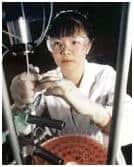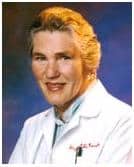International Women’s Day is a global day celebrating the economic, political, and social achievements of women past, present, and future. Celebration of this day varies by region of the world, ranging from a day of general celebration of respect, appreciation, and love toward women to recognizing women’s economic, political, and social achievements. Today, Physician’s Weekly would like to acknowledge just some of the many influential women in medicine.
Patricia S. Goldman-Rakic. Professor of Neurobiology, Neurology, and Psychiatry, Yale University. The persistent firing of neurons in the prefrontal cortex is the “glue of consciousness,” says neurobiologist Goldman-Rakic. “It allows one event in time to connect to another and forms our working memory.” Her pioneering studies show that when this circuitry breaks down because of, for example, fetal damage or substance abuse, our thinking gets derailed, and we’re easily distracted and confused. “The inability to keep a coherent line of thought is one of the cardinal symptoms of schizophrenia and other memory disorders like Alzheimer’s, Parkinson’s, and childhood attention-deficit disorder.”
 Lisa Newman. In 2009 Dr. Lisa Newman took a 16-hour journey to Ghana, Africa, to uncover the mysteries of African American women’s mortal enemy: triple negative breast cancer. Newman, director of the Breast Care Center for the University of Michigan, is at the forefront of the fight against this form of cancer that is twice as likely to strike women of African descent as white woman. Also, women with triple negative breast cancer have a five-year survival rate of 77 percent, compare that with women with other forms of breast cancer, who have a five-year survival rate of 93 percent.
Lisa Newman. In 2009 Dr. Lisa Newman took a 16-hour journey to Ghana, Africa, to uncover the mysteries of African American women’s mortal enemy: triple negative breast cancer. Newman, director of the Breast Care Center for the University of Michigan, is at the forefront of the fight against this form of cancer that is twice as likely to strike women of African descent as white woman. Also, women with triple negative breast cancer have a five-year survival rate of 77 percent, compare that with women with other forms of breast cancer, who have a five-year survival rate of 93 percent.
 Elizabeth Blackburn. Professor of Biochemistry and Biophysics, University of California at San Francisco. Each time a cell divides, its chromosomes shorten slightly. To protect vital genes from being lopped off, chromosomes are capped with telomeres, blocks of DNA and protein. Telomeres are maintained by telomerase, an enzyme discovered by Blackburn (see story, “Why Science Must Adapt to Women”) and biologist Carol Greider. In most healthy cells, telomerase production eventually ceases, telomeres whittle down, and the cell dies. Blackburn’s research has shown that in cancer cells, the enzyme never shuts off, and cells become immortal: “Telomerase is reactivated in about 90 percent of tumors. It is a great favorite of cancer cells,” and thus a target for new drugs.
Elizabeth Blackburn. Professor of Biochemistry and Biophysics, University of California at San Francisco. Each time a cell divides, its chromosomes shorten slightly. To protect vital genes from being lopped off, chromosomes are capped with telomeres, blocks of DNA and protein. Telomeres are maintained by telomerase, an enzyme discovered by Blackburn (see story, “Why Science Must Adapt to Women”) and biologist Carol Greider. In most healthy cells, telomerase production eventually ceases, telomeres whittle down, and the cell dies. Blackburn’s research has shown that in cancer cells, the enzyme never shuts off, and cells become immortal: “Telomerase is reactivated in about 90 percent of tumors. It is a great favorite of cancer cells,” and thus a target for new drugs.
 Patricia Era Bath. As breakthroughs in medicine go, the Laserphaco Probe ranks pretty high on an ophthalmologist’s list. Invented by Dr. Patricia Bath, an ophthalmologist, the tool is used globally to help in the removal of cataract lenses. Also the good doctor received a patent to use ultrasound technology to treat cataracts. Dr. Bath is also the founder of the American Institute for the Prevention of Blindness in Washington D.C.
Patricia Era Bath. As breakthroughs in medicine go, the Laserphaco Probe ranks pretty high on an ophthalmologist’s list. Invented by Dr. Patricia Bath, an ophthalmologist, the tool is used globally to help in the removal of cataract lenses. Also the good doctor received a patent to use ultrasound technology to treat cataracts. Dr. Bath is also the founder of the American Institute for the Prevention of Blindness in Washington D.C.
 Margaret A. Liu. Vice Chairman, Transgene, Strasbourg, France HIV mutates so quickly that it can outmaneuver traditional vaccines made from viral proteins or weakened viruses. Worse, a vaccine made from a weakened virus could prove deadly if the virus mutated and regained virulence. Liu’s work has shown that DNA may offer “the hope of better, more stable vaccines that can be rapidly produced.” DNA injected as a vaccine might signal the body to churn out proteins that protect against HIV by provoking an immune response to the virus.
Margaret A. Liu. Vice Chairman, Transgene, Strasbourg, France HIV mutates so quickly that it can outmaneuver traditional vaccines made from viral proteins or weakened viruses. Worse, a vaccine made from a weakened virus could prove deadly if the virus mutated and regained virulence. Liu’s work has shown that DNA may offer “the hope of better, more stable vaccines that can be rapidly produced.” DNA injected as a vaccine might signal the body to churn out proteins that protect against HIV by provoking an immune response to the virus.
Janet Rowl ey. Professor of Medicine, Division of Hematology and Oncology, University of Chicago Medical Center. One afternoon in 1972, sitting at her dining room table studying images of the chromosomes of a leukemia patient, Rowley noticed that chunks from two chromosomes had swapped places. This swapping, or translocation, is now known to cause several forms of cancer. “It fuses together pieces of two genes that are normally far apart, creating a new gene that turns the cell malignant,” says the physician. “By knowing what those genes do, we can develop targeted drug treatments.” One of these drugs, Gleevec, is already on the market.
ey. Professor of Medicine, Division of Hematology and Oncology, University of Chicago Medical Center. One afternoon in 1972, sitting at her dining room table studying images of the chromosomes of a leukemia patient, Rowley noticed that chunks from two chromosomes had swapped places. This swapping, or translocation, is now known to cause several forms of cancer. “It fuses together pieces of two genes that are normally far apart, creating a new gene that turns the cell malignant,” says the physician. “By knowing what those genes do, we can develop targeted drug treatments.” One of these drugs, Gleevec, is already on the market.


